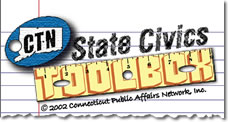|
|
CT-N Legislative Session Click Here for the Word Document version of this page. |
Video Session: Use an appropriate taped CT-N session of the
Connecticut House of Representatives or Senate discussing a bill with
clearly defined party arguments. Check our
Hot Topics page for ideas.
Common Core State Standards:
W1: Write arguments focused on
discipline-specific content.
a.
Introduce claim(s) about a topic or issue, acknowledge and distinguish
the claim(s) from alternate or opposing claims, and organize the reasons
and evidence logically.
b. Support
claim(s) with logical reasoning and relevant, accurate data and evidence
that demonstrate an understanding of the topic or text, using credible
sources.
c. Use words, phrases
and clauses o create cohesion and clarify the relationships among
claim(s), counterclaims, reasons, and evidence.
d.
Establish and maintain a formal style.
e.
Provide a concluding statement or section that follows from and supports
the argument presented.
W7: Conduct short research projects to answer
a question (including a self-generated question), drawing on several
sources and generating additional related, focused questions that allow
for multiple avenues of exploration.
Content: Students
will choose a topic presented in the CT-N sessions, conduct a short
research project on that topic and write a thesis-driven paper
presenting their argument on that topic.
Additional Materials
Needed:
- Technology to show the CT-N session debates
- Computers/access to internet for research
- Thomas.gov
- Bill of Rights Institute
- First Amendment Center
- Annenberg Classroom
- Gale U.S. History in Context database (if available)
- ICONN database (if available)
Useful Classroom Resources:
Research Process Video
How To Annotate
Paraphrasing Video
How To Write a
Thesis Statement 1
How To Write a Thesis Statement 2
How To Write a Thesis Statement 3
Class Time: 7-10 days.
Objectives: Students will: conduct a short research project on a
topic discussed in one of the CT-N bill discussions, generate a thesis
based on an argument for or against that topic, and write about their
argument clearly, coherently and formally in the form of a thesis-driven
paper.
Activity:
- (Day One) Students should be introduced to the short research project. Explain that they will be presented with topics to choose from found on the CT-N Hot Topics Page which they may conduct their research on. They may want to think about this and decide on their topic the night before for homework.
- Once students have decided on a topic that interests them, provide the students with access to view the particular legislative session debate that focuses on their topic. While they watch, students should be taking notes on arguments both for and against this topic. Full versions of these debates are available from the CT-N website. Explain to the students that ultimately they will be taking a side and generating a thesis on that topic which will be supported by evidence found in their research. However, they do need to acknowledge and address alternate arguments on that topic which may be presented during the debate they watch. For homework, students should generate their own research questions and come prepared with them to class the next day.
- (Day Two-Four) Students will be given access to computers and the internet to begin their research. Students will be provided with some starting points for their research such as Thomas.gov, Bill of Rights Institute, First Amendment Center, and Annenberg Classroom. As students find useful articles and sources, they should annotate and highlight them, take notes on them and write down all of their citation information.
- (Day Five) Once students have an adequate amount of sources with notes, they should spend this day generating their thesis and organizing their ideas. Their thesis needs to be supported by evidence, and therefore the research needs to happen prior to generating the thesis. This thesis should be checked and approved by the teacher and revised if necessary.
- (Day Six) Once their thesis is approved, students should start to organize their information and create a rough outline for their paper. Within their paper, students will introduce their topic or issue, make their claim/thesis, acknowledge and distinguish the claim from alternate or opposing claims, support their claim with logical reasoning and relevant, accurate data and evidence that demonstrate an understanding of the topic or text, using credible sources, and finally provide a concluding statement or section that follows from and supports the argument presented.
- (Day Seven-Ten) Students should be given time to write their thesis-driven papers using their outlines during class. If you prefer to have students write their papers outside of class, class time can be used to conference with students, peer-edit and/or revise papers.
Debrief/Closure: Students should be required to present
their arguments and the research they found to support their argument in
some form, such as an oral presentation or power-point.
If you have any comments or suggestions about this activity or would like to submit your own activity, please contact me and share your ideas.
